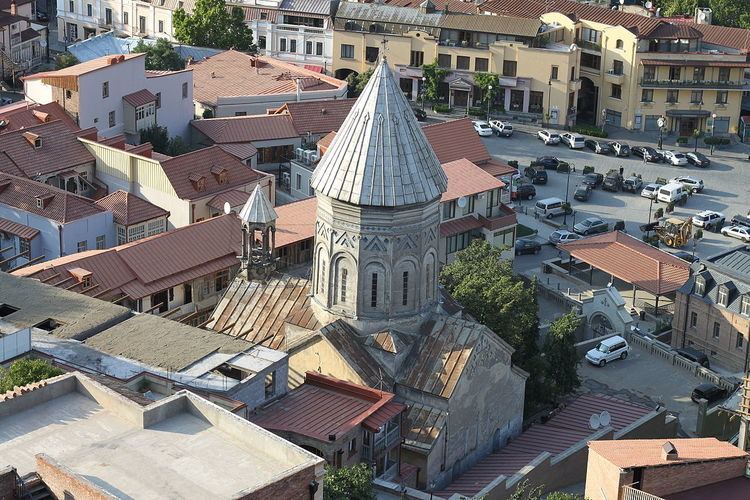Completed 1251 Opened 1251 | Status active | |
 | ||
Similar Norashen Church - Tbilisi, Rustaveli Theatre, Saint Gevork Monaster, Ejmiatsin Church - Tbilisi, Church of the Red Gospel - T | ||
Church of saint george surb gevorg tbilisi georgia
The Cathedral of Saint George (Armenian: Սուրբ Գևորգ եկեղեցի, Surb Gevorg yekeghetsi; Georgian: სურბ გევორგის ეკლესია, surb gevorgis ek'lesia or სურფგევორქი, surpgevorki) is a 13th-century Armenian church in the historical quarter of Tbilisi, Georgia's capital. It is one of the two functioning Armenian churches in Tbilisi and is the cathedral of the Georgian Diocese of the Armenian Apostolic Church. It is located in the south-western corner of Vakhtang Gorgasali Square (Meidani) and is overlooked by the ruins of Narikala fortress.
Contents
- Church of saint george surb gevorg tbilisi georgia
- History
- Renovations
- Architecture and frescoes
- Burials
- References
History
According to Armenian historians Hovsep Orbeli and Levon Melikset-Bek the church was founded in 1251. The date was proposed based on an Arabic inscription on a khachkar over the western door of the church yard. According to 13th century chronicler Hovhannes Erznkatsi, the church was built by Prince Umek of Karin (Erzurum). Jean-Michel Thierry wrote that the cathedral was commissioned in 1251 by a wealthy merchant named Umek of Karin (Erzerum) who settled in Tiflis in the 13th century, and married Princess Mama Vahtangian, the daughter of Hasan Jalal Vahtangian, Grand Prince of Khachen (ruled 1214-1261). However, the Diocese of the Armenian Apostolic Church in Georgia website claims that the church existed long before 1251 and that the Arabic inscription does not prove that the church was built in the 13th century and Hovhannes Erznkatsi refers to the church being rebuilt and not built by Umek.
Renovations
According to Thierry, the church was thoroughly restored in the 17th century, and then again in 1832 and 1881.
The most recent renovation of the church began in 2012. Initiated and financed by Russian-Armenian businessman Ruben Vardanian, the renovation was supported by donations of philanthropists Albert Avdolyan, Sergey Sarkisov and Rusudan Makhashvili, Danil Khachaturov, former Georgian Prime Minister Bidzina Ivanishvili, and others. Some $3.5 million was spent on its renovation, which was completed in 2015. The cathedral was reconsecrated on October 31, 2015 by Catholicos Karekin II, the head of the Armenian Church. The ceremony was attended by Armenian President Serzh Sargsyan and former Georgian Prime Minister Bidzina Ivanishvili.
Architecture and frescoes
The cathedral is built on a traditional plan of a partitioned, open cross with a rectangular perimeter. Like most of the churches in Tbilisi, it is built in brick.
Late 18th-century painting by Hovnatan Hovantanian decorate the church's interior. Between 1922 and 1923 Gevorg Bashinjaghian decorated the church's internal walls, the altar, and the walls in front of it, creating four large murals: Jesus in the Garden of Gethsemane, The Repentance of Judas, Jesus and the Boatmen, Harvest time.
The outer walls of the church is covered with stucco.
Burials
The following people are buried at the church courtyard:
